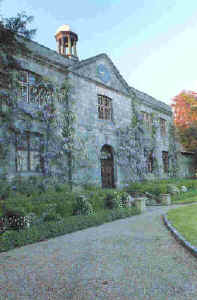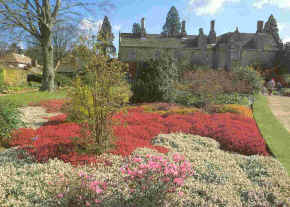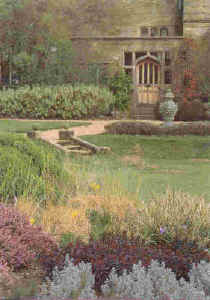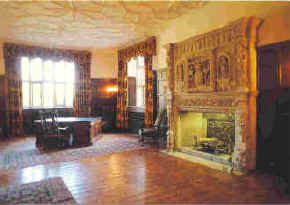Wakehurst Place:
The Culpeper Connection
(Continued)
 In 1890, Lady Downshire sold Wakehurst to Mr. T.
W. Boord, MP, a local man, who was made a baronet six years
after the purchase and from, then on was known as Sir William.
Having formerly lived at nearby Cuckfield, he obviously knew the
property well and probably had an eye to restoring it still
further and then selling it. Despite all Lady Downshire's
improvements, its structure was very unsound and Sir William set
about its restoration in a very business-like manner. This took
him thirteen years to complete, at the end of which time he sold
it to Gerald Loder, one of Wakehurst's most affectionately
remembered owners.
In 1890, Lady Downshire sold Wakehurst to Mr. T.
W. Boord, MP, a local man, who was made a baronet six years
after the purchase and from, then on was known as Sir William.
Having formerly lived at nearby Cuckfield, he obviously knew the
property well and probably had an eye to restoring it still
further and then selling it. Despite all Lady Downshire's
improvements, its structure was very unsound and Sir William set
about its restoration in a very business-like manner. This took
him thirteen years to complete, at the end of which time he sold
it to Gerald Loder, one of Wakehurst's most affectionately
remembered owners.
Gerald Loder obviously cared for his new home
and wrote a carefully researched book on the history of
Wakehurst Place and its owners that was published in 1907. But
the garden was his first love. In 1903, when he bought
Wakehurst, he Junior Lord of the Treasury but left Parliament in
1906 and devoted his tone from then on to replanting and shaping
the grounds. Lady Boord described in The Ladies Field,
1901, as 'her own head gardener ', had also been a keen
horticulturalist and designed and helped plant the rockery.
Gerald Loder's contribution to the garden, in the thirty-three
years he lived there, was a great deal more, but much of it was
owed to Alfred Coates, Loder's head gardener, who was later
commemorated by having Coates Wood named after him. This was
appropriate as his particular interest was trees. Apparently at
his interview for the post Loder asked him, "What shall it
be? Flowers or trees and shrubs?" To which Coates replied,
"l reckon trees and shrubs, Sir" and got the job, for
this was Loder's preference, too. So trees and shrubs it was,
and between them, Loder and Coates began replanting the grounds.
In this they were partners, each respecting the other's point of
view, and if Loder had the upper hand as owner, Coates had the
edge on him in terms of horticultural know-how. Gardening is a
great leveler between people, whatever their stations. Sad to
say, much of their work was destroyed in the Great Storm of
October 1987, including a row of cedars that Loder had grown
from seed.
 Coates was still head gardener when Loder, who
was made Lord Wakehurst in 1934, died in 1936. And still there
in 1938 to give advice to Wakehurst's new owner, Sir Henry
Price, who had made his fortune making off-the-peg suits and was
known as the 'Fifty Shilling Tailor'. War had begun and, in
1941, Wakehurst became the billet of the Canadian Corps, many of
whom fell in the Dieppe raid of that year.
Coates was still head gardener when Loder, who
was made Lord Wakehurst in 1934, died in 1936. And still there
in 1938 to give advice to Wakehurst's new owner, Sir Henry
Price, who had made his fortune making off-the-peg suits and was
known as the 'Fifty Shilling Tailor'. War had begun and, in
1941, Wakehurst became the billet of the Canadian Corps, many of
whom fell in the Dieppe raid of that year.
Shortly after the war, Coates
retired - though he remained close at hand - and Reginald
Wallis, who had formerly been head gardener at Woburn Abbey,
replaced him. It was actually Wallis who, though indirectly,
instilled Sir Henry with an interest in plants. The story goes
that Sir Henry, while reading The Times one morning,
noticed that several exhibits shown by Wallis at the Royal
Horticultural Society's show had won prizes. Needless to say he
was immediately eager to see the plants for himself and from
then on took more interest in the gardens in which he had a wall
constructed around the old kitchen garden.
 Lady Eve Price needed no such encouragement and
she and Sir Henry will always be remembered in horticulture by
the various plants that were named after them. These include
Rosa 'Eve Price', Viburnum tinus 'Eve Price', Carnassia
leichtlinii 'Eve Price' and Pieris formosa 'Henry Price'.
Lady Eve Price needed no such encouragement and
she and Sir Henry will always be remembered in horticulture by
the various plants that were named after them. These include
Rosa 'Eve Price', Viburnum tinus 'Eve Price', Carnassia
leichtlinii 'Eve Price' and Pieris formosa 'Henry Price'.
Sir Henry died in December 1963 and in his will
he generously bequeathed the estate to the National Trust who
subsequently leased it to Kew for ninety-nine years, beginning
on 1 January 1965. For a few years after her husband's death
Lady Price continued to live in the mansion but later gave up
her life tenancy rights that were then added to the National
Trust lease of the gardens. However, she retained a keen
interest in her former home and in September 1982 officially
opened the Lady Price Room, once the Library, in which she had
some of her own antique furniture installed.

Lady Price Room at Wakehurst
Wakehurst Place is rich in memorabilia of its
former owners: Sir Edward Culpeper's initials carved on the
spandrells over the old South entrance; the date, 1590, carved
on the door which Lady Downshire had moved to the east side;
Lady Boord's rock garden, now the Rock Terraces; Gerald Loder's
heath garden, the pineturn and the Loder Valley Reserve; the Sir
Henry Price Garden; and of course all, the thousands of plants
which grow there.
To sit in these Gardens in the summertime, when
their beauty is most vivid, brings to mind all the long history
of Wakehurst Place. It is easy to imagine that, having spent his
childhood so nearby, Nicholas Culpeper, the herbalist, was once
a visitor too and many of his herbs can be seen growing
alongside different plants beloved by those who lived there. In
this way the four centuries of the Mansion are represented; the
plants of the past and the present are inseparable, and the
future will undoubtedly add still more to the continuing story
of Wakehurst Place.
Also See: Ardingly
Church